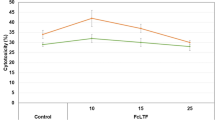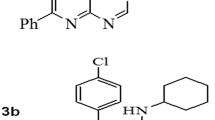Summary
The mechanism of natural killer (NK) cytotoxicity activation of human peripheral blood mononuclear cells (PBMC) by CySF-L2 was elucidated. CySF-L2 is a cytotoxicity-stimulating factor isolated from dialysable human leucocyte extract, which activates NK cytotoxicity against NK-sensitive and insensitive tumour cells (K562; Daudi; Raji; MOLT4) when preincubated with effector cells for 72 h. CySF-L2-mediated activation was synergistic to interleukin-2(IL-2)-mediated activation of NK cytotoxicity. Induction of interferon γ (IFNγ) release was the crucial step during CySF-L2-mediated NK cytotoxicity activation since enhancement of NK activity was completely blocked when anti-IFNγ antibodies were present during treatment of PBMC. Anti-IFNα, anti-TNFα (tumour necrosis factor α) anti-IL-1 and anti-IL-2 antibodies showed no blocking effect. Analysis of the supernatant culture medium after 72 h incubation of PBMC and their highly purified subpopulations demonstrated that CySF-L2 induced release of IFNγ from CD3+T cells and CD56+CD3− NK cells and of TNFα and prostaglandin E2 from monocytes. CySF-L2 was also capable of activating NK cytotoxicity of highly purified (98%) CD56+CD3− NK cells as well as of monocytes (94% pure). Cell cooperation studies connected with analysis of cytokine release and enhancement of NK cytotoxicity indicated that CySF-L2 might play an essential role in the up and down regulation of NK cytotoxicity by the cytokine network.
Similar content being viewed by others
References
Adams DO, Hamilton TA (1984) The cell biology of macrophage activation. Annu Rev Immunol 2: 283–318
Bøyum A (1968) Isolation of mononuclear cells and granulocytes from human blood. Scand J Clin Lab Invest 21 [Suppl 97]: 77–89
Dinarello DA, Cannon JG, Wolff SM, Bernheim HA, Beutler B, Cerami A, Figari IS, Palladino MA, O'Connor JV (1986) Tumour necrosis factor (cachectin) is an endogenous pyrogen and induces production of interleukin 1. J Exp Med 163: 1433–1450
Doelker I, Voetsch W, Anderer FA (1989) Activation of antitumour cytotoxicity of human blood mononuclear cells by a basic factor from dialysable human leukocyte extract. Anticancer Res 9: 1915–1920
Einhorn S, Blomgren H, Strander H (1978) Interferon and spontaneous cytotoxicity in man: I. Enhancement of the spontaneous cytotoxicity of peripheral lymphocytes by human interferon. Int J Cancer 22: 405–412
Farrar WL, Birchenall-Sparks MC, Young HB (1986) Interleukin 2 induction of interferon γ mRNA synthesis. J Immunol 137: 3836–3840
Feinman R, Henriksen-DeStefano DH, Tujimoto M, Vilcek J (1987) Tumour necrosis factor is an important mediator of tumour cell killing by human monocytes. J Immunol 138: 635–640
Gerrard TL, Terz JJ, Kaplan AM (1980) Cytotoxicity to tumor cells of monocytes from normal individuals and cancer patients. Int J Cancer 26: 585–593
Grimm EA, Rosenberg SA (1984) The human lymphokine-activated cell phenomenon. In: Pick E (ed) Lymphokines, vol 9. Academic Press, New York, pp 279–311
Hamprecht K, Voetsch W, Anderer FA (1986) Activation of human monocyte and natural killer cell-mediated cell killing by two dialyzable thymic factors. Scand J Immunol 24: 59–71
Hamprecht KH, Voetsch W, Anderer FA (1989) A dialysable acid factor from human leukocyte extracts activates tumor cell lysis mediated by human monocytes and natural killer cells. Onkologie 12: 120–127
Herberman RB, Ortaldo JR, Bonnard GD (1979) Augmentation by interferon of human natural and antibody-dependent cell-mediated immunity. Nature 277: 221–223
Herberman RB, Ortaldo JR, Rubinstein M, Pestka S (1981) Augmentation of natural and antibody-dependent cell-mediated cytotoxicity by pure human leukocyte interferon. J Clin Immunol 3: 149–153
Ibayashi Y, Hoon DSB, Golub SH (1987) The regulatory effect of adherent cells on lymphokine-activated killer cells. Cell Immunol 110: 368–378
Kimber I, Moore M (1985) Mechanism and regulation of natural cytotoxicity. Exp Cell Biol 53: 69–84
Klein E, Klein G, Nadkarni JS, Nadkarni JJ, Wigzell H, Clifford P (1968) Surface IgM-kappa specificity on a Burkitt lymphoma cell in vivo and in derived culture cell lines. Cancer Res 28: 1300–1310
Koff WC, Fogler WE, Gutterman J, Fidler IJ (1985) Efficient activation of human blood monocytes to tumoricidal state by liposomes containing human recombinant gamma interferon. Cancer Immunol Immunother 19: 85–89
Kohase MD, Henriksen-DeStefano D, May LT, Vilcek J, Seghal PB (1986) Induction of beta 2-interferon by tumour necrosis factor: a homeostatic mechanism in the control of cell proliferation. Cell 45: 659–666
Korzeniewski C, Callewaert DM (1983) An enzyme release assay for natural cytotoxicity. J Immunol methods 64: 313–332
Krisnamurti C, Ahrens P, Ankel H (1987) Differential effects of beta and gamma interferons on natural killer cell-mediated lysis of lung carcinoma cells. Immunobiology 174: 221–232
Lanier LL, Phillips JH (1988) Effectors, repertoire and receptors involved in lymphocyte-mediated MHC-unrestricted cytotoxicity. Ann Inst Pasteur Immunol 139: 450–456
Leighton JD, Pfeilschifter J (1990) Interleukin 1 and tumor necrosis factor-stimulation of prostaglandin E2 synthesis in MDCK cells, and potentiation of this effect by cycloheximide. FEBS Lett 259: 289–292
Leung KG (1989) Inhibition of human NK cell and LAK cell cytotoxicity and differentiation by PGE2. Cell Immunol 123: 384–395
Leung KH, Koren HS (1982) Regulation of human natural killing: II. Protective effect of interferon on NK cells from suppression by PGE2. J Immunol 129: 1742–1747
Limb GA, Meager A, Wooley J, Wadhwa M, Biggerstaff J, Brown KA, Wolstencroft RA (1989) Release of cytokines during generation of lymphokine-activated killer (LAK) cells by IL-2. Immunology 68: 514–519
Lozzio CB, Lozzio BB (1975) Human chronic myelogenous leukemia cell line with positive Philadelphia chromosome. Blood 45: 321–334
Miltenyi S, Müller W, Weichel W, Radbruch A (1990) High gradient magnetic cell separation with MACS. Cytometry 11: 231–238
Minowada J, Ohnuma T, Moore GE (1972) Rosette-forming human lymphoid cell lines: I. Establishment and evidence for origin of thymus-derived lymphocytes. J Natl Cancer Inst 49: 891–895
Mueller EA, Anderer FA (1990) Synergistic action of a plant galacturonan enhancing antitumor cytotoxicity of human natural killer cells: chemical specificity of target cell recognition. Cancer Res 50: 3646–3651
Mueller EA, Anderer FA (1990) AViscum album oligosaccharide activating human natural cytotoxicity is an interferon γ inducer. Cancer Immunol Immunother 32: 221–227
Munker R, Grasson J, Ogawa M, Koeffler HP (1986) Recombinant human TNF induces production of granulocyte-monocyte colonystimulating factor. Nature 323: 79–82
Ortaldo JR, Longo DL (1988) Human natural lymphocyte effector cells: definition, analysis of activity and clinical effectiveness. J Natl Cancer Inst 80: 999–1010
Østensen ME, Thiele DL, Lipsky PE (1987) Tumor nectrosis factor α enhances cytolytic activity of human natural killer cells. J Immunol 138: 4185–4191
Patell SS, Thiele DL, Lipsky PE (1987) Major histocompatibility complex-unrestricted cytolytic activity of human T cells: analysis of precursor frequency and effector phenotype. J Immunol 139: 3886–3895
Pflueger E, Mueller EA, Anderer FA (1990) Preservation of cytotoxic function during multi-cycle immunomagnetic cell separations of human NK cells using a new type of magnetic bead. J Immunol Methods 129: 165–173
Philip R, Epstein LB (1986) Tumour necrosis factor as immunomodulator and mediator of monocyte cytotoxicity induced by itself, γ-interferon and interleukin 1. Nature 323: 86–89
Pulvertaft RJV (1964) Cytology of Burkitt's tumour: African lymphoma. Lancet 1: 238–244
Siegel JP, Sharon M, Smith PL, Leonard WJ (1987) The IL-2 receptor for beta-chain (p 70): role in mediating signals for LAK, NK and proliferative activities. Science 238: 75–78
Timonen T, Saksela E, Ranki A, Häyry P (1979) Fractionation, morphological and functional characterization of effector cells responsible for human natural killer activity against cell-line targets. Cell Immunol 48: 133–148
Trinchieri G, Matsumoto-Kobyashi M, Clark SC, Sheehra J, London L, Perussia B (1984) Response of resting human peripheral blood natural killer cells to interleukin 2. J Exp Med 160: 1147–1169
Tsudo M, Goldman CK, Bongiovanni KF, Chan WC, Winton EF, Yagita M, Grimm EA, Waldman TA (1987) The p75 peptide is the receptor for interleukin 2 expressed on large granular lymphocytes and is responsible for the interleukin 2 activation of these cells. Proc Natl Acad Sci USA 84: 5394–5398
Author information
Authors and Affiliations
Rights and permissions
About this article
Cite this article
Doelker, I., Anderer, F.A. The CySF-L2 factor from dialysable human leucocyte extract activates natural killer cytotoxicity by induction of interferon γ. Cancer Immunol Immunother 34, 299–305 (1992). https://doi.org/10.1007/BF01741550
Received:
Accepted:
Issue Date:
DOI: https://doi.org/10.1007/BF01741550




